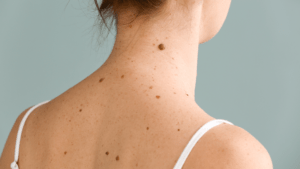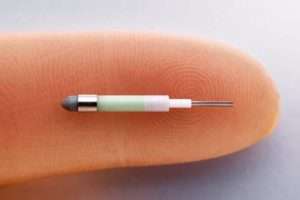As experts in dermatological care, we understand the nuances and complexities involved in skin cancer treatment.
We’ll provide a general timeline for the healing process, helping you set realistic expectations for your recovery. Additionally, you’ll find immediate post-surgery care instructions, which are essential in ensuring a safe and effective healing journey.
Types of Cancer on Skin
Understanding the various types of skin cancer is crucial for recognizing early signs and seeking appropriate treatment. At Dermatology of Seattle, we emphasize the importance of awareness and early detection. Here, we outline the main types of skin cancer, each with its unique characteristics and treatment approaches.
Basal Cell Carcinoma (BCC)
- Appearance: BCC often appears as a slightly transparent bump on the skin, though it can take other forms. It might look like a pearly or waxy bump, a flat, flesh-colored, or brown scar-like lesion, or a bleeding or scabbing sore that heals and then returns.
- Common Locations: Typically develops in areas frequently exposed to the sun, such as the face and neck.
- Treatment: Options include surgical removal, topical treatments, and in some cases, radiation therapy.
Squamous Cell Carcinoma (SCC)
- Appearance: SCC may appear as a firm, red nodule or a flat lesion with a scaly, crusted surface.
- Common Locations: Commonly found on the face, ears, and hands but can occur anywhere on the body.
- Treatment: Surgical excision, cryotherapy, and photodynamic therapy are among the treatment options.
Melanoma Skin Cancer
- Appearance: Melanoma is known for its ability to develop in existing moles or appear suddenly as a new dark spot on the skin. It’s typically characterized by a change in an existing mole or the development of a new pigmented or unusual-looking growth on your skin.
- Common Locations: Can develop anywhere on the body, in otherwise normal skin or in an existing mole that becomes cancerous.
- Treatment: Treatment usually involves surgery to remove the melanoma. Advanced melanoma may require additional treatments, such as chemotherapy, radiation therapy, or immunotherapy.
Less Common Skin Cancers
- These include Merkel cell carcinoma, skin lymphoma, and other rare types. These cancers can vary significantly in appearance, location, and severity.
Understanding Different Skin Cancer Surgeries and What to Expect
Undergoing surgery for skin cancer can be a significant event in one’s life. At Dermatology of Seattle, we believe that being well-informed about the types of surgeries and what to expect during skin cancer recovery is key to a smoother, more comfortable healing process. Here’s an overview of the common skin cancer surgeries and what patients can typically expect post-procedure.
Excisional Surgery
- Procedure: This surgery involves cutting out the cancerous tissue along with a margin of healthy skin around it.
- What to Expect: Recovery time varies based on the size and location of the excision. Smaller excisions may heal within a few weeks, while larger ones may take longer. Stitches are usually removed within a week or two.
Mohs Micrographic Surgery
- Procedure: A highly precise method where cancerous cells are removed layer by layer and examined under a microscope during the surgery. The process continues until only cancer-free tissues remain.
- What to Expect: Mohs surgery has a high cure rate and often leaves smaller scars. Recovery generally involves close monitoring of the wound and regular follow-up visits. Complete removal and healing can take a few weeks to a few months, depending on the extent of the surgery.
Cryosurgery
- Procedure: Used primarily for pre-cancers and small, superficial skin cancers, this technique involves freezing cancer cells with liquid nitrogen.
- What to Expect: The treated area may blister and form a scab, which typically heals within a few weeks. The procedure is less invasive, making recovery quicker and generally easier than more extensive surgeries.
Laser Surgery
- Procedure: A focused beam of light is used to destroy cancerous cells, often used for superficial skin cancers.
- What to Expect: Healing from laser surgery is usually faster than traditional surgical methods. Patients may experience redness and sensitivity in the treated area for a short period.
Radiation Therapy
- Procedure: Though not a surgical procedure, radiation therapy is sometimes used for skin cancer treatment. It involves using high-energy particles or waves to destroy or damage cancer cells.
- What to Expect: The skin in the treated area may look and feel sunburned, and recovery may involve managing these symptoms.
Detailed Guide to Post-Surgical Wound Care and Management
Proper care of your surgical wound is a crucial step in the healing treatment after skin cancer surgery. At Dermatology of Seattle, we emphasize the importance of effective wound management to promote healing and minimize scarring.
Keeping the Wound Clean
- Gentle Cleaning: Clean the wound as advised by your surgeon. Typically, this involves gently washing it with soap and water and then patting it dry.
- Avoiding Irritants: Avoid harsh chemicals or alcohol-based products that irritate the wound.
Dressing the Wound
- Type of Dressing: Use the specific type of dressing (gauze, bandages, etc.) recommended by your doctor.
- Changing Frequency: Change your dressings as often as instructed to prevent infection and absorb drainage.
- Sterile Technique: Ensure your hands are clean, and use sterile techniques when changing dressings to reduce the risk of infection.
Monitoring for Signs of Infection
- What to Look For: Keep an eye out for increased redness, swelling, warmth, or drainage, as these can be signs of infection.
- Immediate Action: If you notice any signs of infection, contact your healthcare provider immediately.
Managing Scarring
- Ointments and Creams: After the wound has healed, use silicone-based ointments or gels as recommended to minimize scarring.
- Massage: Gentle massage of the area (once healed) can help reduce scar tissue buildup.
Sun Protection
- Avoiding Sun Exposure: Keep the healing wound out of the sun to prevent darkening and further damage.
- Using Sunscreen: Once the wound has healed, apply sunscreen to the area to protect the new skin.
Activity Restrictions
- Limiting Movement: Avoid activities that might stretch or stress the wound area for as long as your doctor advises.
- Gradual Resumption: Gradually resume normal activities per your healthcare provider’s guidance.
- Nutrition and Hydration
- Healthy Diet: Eat a balanced diet rich in vitamins and minerals, particularly those that aid in wound healing (like Vitamin C and Zinc).
- Staying Hydrated: Drink plenty of water to keep the skin hydrated and promote healing.
Follow-up Care
- Scheduled Appointments: Contact your doctor for all follow-up appointments to ensure the wound is healing properly.
Final words
Navigating the skin cancer surgery recovery process can be a complex journey, filled with various steps and precautions.
At Dermatology of Seattle, we understand the nuances of this journey and are dedicated to providing our patients with the highest level of care and support.
If you need proprietary guidance through your skin cancer treatment recovery, remember that our team of specialists is here to assist you.






